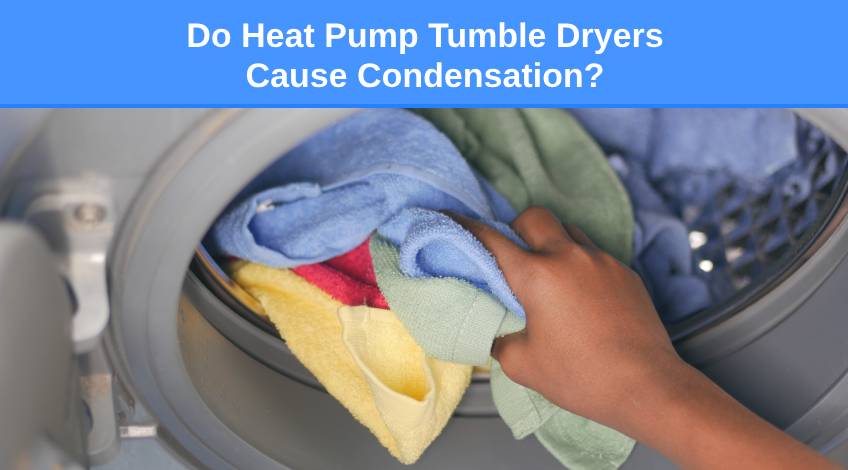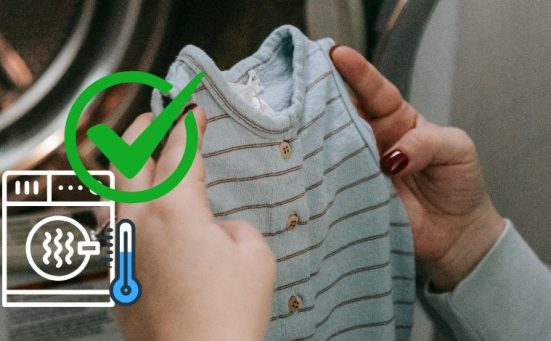
Do Heat Pump Tumble Dryers Cause Condensation?
Heat pump tumble dryers are the latest innovation in the laundry world. They are an upgrade to the condenser dryers which were an upgrade on the vented dryers which started it all.
Many people claim that the main problem with condenser dryers is that they create condensation and that you should upgrade to a heat pump model if you don’t want any condensation in your laundry room.
But is this true? And more importantly, do heat pump dryers cause condensation? If you want to know the answer to these questions, keep reading.
Will A Heat Pump Dryer Create Condensation?
As you probably already know, heat pump dryers work on similar principles to condenser dryers. In as much as neither needs a vent to remove the hot air, and they both rely on a condenser to convert that moist, hot air into water which is stored on-board.
However, condenser dryers waste a lot of that hot air by allowing it to escape from the appliance after the water has been extracted. This can lead to problems with condensation as the hot air settles on colder surfaces in the room and condensates.

Heat Pump Dryers Use Less Heat
Heat pump dryers on the other hand, reuse that warm, now dry air and pump it back through the drum. Saving energy and money as the air doesn’t need to be heated as much to achieve the required drying temperature.
Plus heat pump dryers operate at around 50 degrees C whereas condenser dryers run at around 70 to 75 degrees C so heat pump dryers use less energy anyway.
The heat pump dryer will take considerably longer to dry your clothes but that’s better for the fabrics as they’re less likely to get damaged or stressed.
Plus They Don’t Release The Hot Air
As there is no hot air released from a heat pump dryer, in theory it shouldn’t cause any condensation. However, if the dryer is in a cold room, any heat can cause condensation.
What often happens with heat pump dryers in cold rooms is that the outside metal body of the appliance can become covered in water droplets as the cold air from the room condensates on the warmer metal surface.
Now, the thing you need to realise here is that any hot surface in a cold room can, and often does, cause condensation. Not all dryers are equal either, some brands are better able to cope with heat loss due to better insulation.
However They Can Cause Condensation If The Moisture Sensors Malfunction
Heat pump dryers have moisture sensors which monitor the amount of moisture in the laundry and turn the appliance off once the laundry is dry.
If you use fabric softener or dryer sheets, the moisture sensors can become coated in a wax-like substance which prevents them from detecting the levels of moisture in the drum.
This can add to condensation levels in some cases and should be prevented from becoming a problem. To clean the moisture sensors all you need is a soft cloth and some distilled white vinegar.
The moisture sensors are located near the lint filter in the dryer. Simply dip the soft cloth in white vinegar and gently wipe the moisture sensors to remove any softener buildup.
Excess Condensation Forming On The Dryer
Heat pump dryers are designed to reduce condensation and prevent issues like mould and mildew. This is achieved by condensing the wet hot air and collecting the water converted from the moist air into an on-board reservoir.
If the room the heat pump dryer is in has high humidity, there could be an increase in the amount of water forming on the outside of the condenser coils. This can then spread to any surfaces close by which are cooler than the dryer.
These water droplets will need to be wiped up to prevent mould and mildew from forming.
How To Help Prevent Condensation When Using A Heat Pump Tumble Dryer

By using a heat pump tumble dryer, you will have already drastically reduced the amount of condensation you’re likely to produce. Keeping the room at a decent temperature will help to reduce it even more.
This is because the difference between the temperature of the air and the temperature of the surfaces in the room creates condensation. The greater the difference in these temperatures the more condensation that’s produced.
If you try to maintain your home’s temperature to a reasonable level, you shouldn’t get too much (if any) condensation issues. You should also operate the dryer in a well ventilated room to maintain optimum performance and reduce condensation.
Problems can arise if your dryer is in an outbuilding or garage. This is because it’s more difficult to regulate the room temperature in an outbuilding.
Can Heat Pump Dryers Cause Condensation?
Yes, heat pump dryers can cause condensation, but not in the same way or quantity as other types of dryers. To explain this clearly, we need to look at the way the various dryer types operate:
- Vented Dryers
Vented dryers rely on a vent and vent hose to allow the hot, moist air to leave the appliance. Where it is ejected into the outside of the home. Although this effectively gets laundry dry, it’s a wasteful system and the hot wet air causes lots of condensation. - Condenser Dryers
Condenser dryers turn the hot, moist air back into water which is collected in an on-board water tank which eliminates the need for a vent. But, the now dry, hot air is released into the room where it can often cause condensation. - Heat Pump Dryers
Heat pump dryers use a similar condenser system to extract water from the moist air but the dried air is passed back through the drum to dry the clothes. As this warm air is recycled and not released into the room, there’s less opportunity for condensation to form.
With that said, if the room the heat pump dryer is in is not kept at a decent temperature, there will still be some condensation. The best way to combat condensation issues is by keeping your home at a constant temperature and allowing adequate ventilation.
SEE ALSO: All Tumble Dryer Settings Explained
Frequently Asked Questions
Heat pump dryers don’t release moisture into the room but if the room is colder than the dryer, some condensation can form around the condenser coils.
Heat pump dryers pass hot air through the drum which absorbs moisture from the clothes. This hot, moist air is then passed through a condenser which converts the moisture into water which is collected in a tank. The remaining hot air is then reused to dry the laundry over and over.
If you notice condensation forming around your heat pump dryer, it is most likely caused by the room temperature not being warm enough. To reduce this condensation, increase the temperature of the room to a similar level as the dryer.
Also, follow us on Pinterest ...



